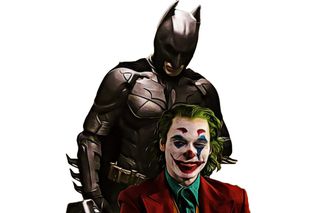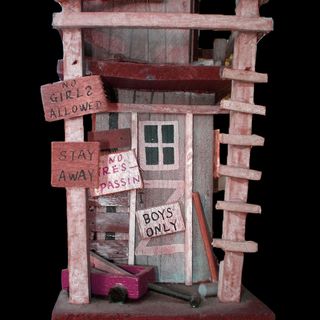
The Batman‑Joker Universe Offers a Crucial Platform to Talk About Mental Health
Madness, as you know, is not like it is in the movies.

“All it takes is one bad day to reduce the sanest man alive to lunacy,” the Joker says to Batman in the 1988 graphic novel The Killing Joke. Two decades later, Heath Ledger described the Joker as a “psychopathic, mass-murdering, schizophrenic clown with zero empathy,” while speaking to The New York Times about his role in The Dark Knight (2008). Joaquin Phoenix as the Joker, at one point in Todd Phillips’ Joker (2019), is seen scribbling into a notepad, “the worst part about having a mental illness is people expect you to behave as if you don’t.” Throughout the character’s evolution, descriptors ‘crazy,’ ‘insane,’ and, ‘mad’ come dime-a-dozen when the Joker is around; the list of diagnoses he has casually received over decades of portrayal, includes schizophrenia, dissociative identity disorder, psychosis, and post-traumatic stress disorder (PTSD).
In DC Comics’ violent Batman-Joker universe, such careless references to mental health and illness are common. But, when said in the context of the Joker — the murderous, nihilistic clown prince of crime; MVP at the Gotham city’s psychiatric hospital for the criminally insane; the most famous Batman villain and arguably the most famous supervillain of all time — it creates a trope that links being mentally ill to being violent, promulgating the idea that people with schizophrenia, PTSD and identity disorders are dangerous. This, then, adds real-life stigma to the lives of those who face mental illness, othering them further.
Circularly, since mental illness has literally been written into the Joker’s character over decades and is now mostly inescapable (even though the original creators did not intend this when they first introduced the Joker’s backstory in The Man Behind The Red Hood), storytellers can use the Batman-Joker universe to talk about mental health in all its shades and nuances.
Diagnosing Batman and the Joker
Examining the various diagnoses the Joker has received so far in various comics, cartoons, and films, since his introduction since the 1950s, leads to only one conclusion: no one knows what mental health issue he has or what makes him ‘mad.’ John Goodwin and Izzat Tajjudin offer a compelling critique of the Joker in “‘What Do You Think I Am? Crazy?’: The Joker and Stigmatizing Representations of Mental Ill-Health”; they go through each casual diagnosis the character has received and try to connect the actual symptoms to the Joker’s behavior and actions. Turns out, if he were a real person who sought professional help instead of watching the world burn, he wouldn’t be diagnosed with any of the disorders allegedly behind his murderous, dangerous actions.
They argue that he’s too high-functioning to be schizophrenic, going by the American Psychiatric Association’s definition of schizophrenia; he always has a plan even though he doesn’t look like a guy who does. They dismiss the Dissociative Identity Disorder diagnoses by attributing the perception of the Joker’s changing personalities to the various evolving narratives over 80 years of the character being tirelessly re-invented.
He’s referred to as a psychotic killer often but shows none of the symptoms of psychosis, such as hallucinations, delusions, incoherent speech. If anything, he’s a criminal mastermind. In The Dark Knight, Ledger-as-Joker memorably says while slouched on the ground against a prison cell’s wall: “I just want my phone call,” before blowing up the police precinct. In Tim Burton’s Batman (1989), the Joker develops and distributes toxic beauty products to kill Gotham’s residents. That’s not a confused, psychotic person; that’s a high-functioning person who in his own words is always “ahead of the curve.”
The Joker is also not insane. The Diagnostic and Statistical Manual of Mental Disorders (DSM) does not list insanity as a disorder — insanity is a legal term to describe a person accused of committing a crime who is not capable of understanding what they were doing or the consequences of their actions. A person deemed insane by a court of law is incapable of differentiating between right and wrong, and the Joker is anything but that. It’s not that he can’t tell one from the other; he just can see that these two distinct categories are all made up by humans as a weak moral code and revels in the sadistic pleasure of tearing the whole damn thing down.
The diagnosis of PTSD comes from his origin story — of which there are many iterations — as written by Alan Moore and Brian Bolland’s controversial classic The Killing Joke. The pair was the first to give the Joker an empathetic backstory as that of a failed stand-up comedian, forced by circumstance into becoming the criminal Red Hood to support his pregnant wife. In most origins stories, he has One Bad Day in which a robbery goes wrong, his pregnant wife is killed, and he escapes only to fall into a vat of chemicals that bleaches his skin and turns his hair green. Joker, starring Phoenix, settles in on this version of the Joker’s backstory by following the life and times of Arthur Fleck, an emotionally stunted, reclusive, struggling stand-up comedian who works as a clown on the side to make ends meet and support himself and his ailing mother. After One Bad Day of ruthless mistreatment at the hands of literally everyone in the movie, Arthur morphs into the supervillain Joker.
Related on The Swaddle:
Unlike The Dark Knight — featuring the most widely accepted canonical version of the Joker, in which the character remembers a different backstory each time — Phoenix’s Joker declared its mission explicitly as to provide a singular backstory for the supervillain. Here is where Hollywood had a chance to flesh out a nuanced understanding of mental illness. But instead, the Joker is shown as suffering from pseudobulbar affect, a neurological condition that occurs after trauma to the brain and results in uncontrollable bursts of emotion at inappropriate moments. But, this condition is decidedly not a mental health disorder; so, when the Joker scribbles the little note about mental illness, or when a mental health professional asks him if he “needs someone to talk to” — as if therapy could fix a neurological condition — the movie makes the grievous error of stigmatizing mental health and further obfuscating an already taboo and foggy topic. The movie bravely attempts to look at mental illness through the lens of social oppression, but tragically fails as it mixes it up with a neurological condition — and then goes one step further to associate the Joker’s misdiagnosed condition with violence.
“The worst stereotypes come out in such depictions: mentally ill individuals as incompetent, dangerous, slovenly, undeserving. The portrayals serve to distance ‘them’ from the rest of ‘us,'” Stephen Hinshaw, a professor of psychology at the University of California–Berkeley, told US News & World Report in 2015.
“Even though people with mental illness are less likely to commit violent crimes than the mean, and are more likely to be victimized by them, the news media regularly speculates as to whether certain violent criminals have mental health issues (as opposed to just being, you know, bad people),” writes Matthew Rozsa in Salon. He cites other examples — James McAvoy’s villain in the 2017 movie Split, Anthony Perkins’ legendary portrayal of Norman Bates in Psycho, or the entire Hannibal Lecter series — that reinforce this stereotype “by frequently giving their character an explicit or implied diagnosis to explain why they’re bad.” It is a form of subtextual coding; prejudice is oppressive when it’s overt, but there is something more insidious when it is reinforced covertly, especially through a medium as compelling as storytelling.
It’s also interesting how the concept of One Bad Day links the Joker to Batman, his archnemesis. Both of their lives changed in a single night, both experienced terrible loss. Batman lost his parents; the Joker lost his pregnant wife, after which both took to living on the margins of society as outlaws — at the edges of the pendulum of trauma, swinging from being traumatized to coping, from evil to good. But apart from implying this by placing the duo’s origin stories next to each other, Batman-Joker narratives do little to explore the sweeping area between the two extreme manifestations of trauma and the gradient that mental illnesses usually fall into.
“There is still a misunderstanding to the portrayal of insanity in the Batman films and movies and what it means to be legally insane,” Dr. Vasilis K. Pozios, a physician specializing in forensic and adult psychiatry, told Huffington Post. “For instance, the Joker has been repeatedly hospitalized at the Elizabeth Arkham Asylum for the Criminally Insane, even though, in real life, he probably wouldn’t qualify.” Each time, the Joker has been held accountable for his actions, he has gotten out on account of the insanity plea — which just doesn’t hold since no mental health issue covered under the legal recourse fits the Joker’s whatever-that-creepy-smile-is thing.
This leaves the question unanswered: why does Joker do what he does?
Not sick, just a murderous psychopath
Goodwin and Tajjudin argue that the Joker is most likely a psychopath — as depicted in “Mad Love,” an episode in The New Batman Adventures (1997 to 1999) — going by his inflated self-worth, lack of empathy and remorse, and proclivity to violence. In this depiction, he manipulates Arkham Asylum worker Harleen Quinzel (or, Harley Quinn) into believing he isn’t actually mentally unstable, but a tortured, lost soul who became the bad guy after facing years of abuse at home. After she helps him escape from Arkham, he emotionally and physically abuses her. If this diagnosis of being a high-functioning psychopath is correct, then the Joker is very much guilty for all his crimes since psychopathy is classified as a personality construct and not a mental illness that can be treated by medication.
The same goes for Anti-Social Personality Disorder (APSD), the Joker’s motivation for evil as depicted in the 1960s’ Batman TV show. According to MatPat’s Game Theory episode on Batman’s rogues’ gallery, the Joker suffers from this particularly challenging type of personality disorder, which is characterized by impulsive, irresponsible and often criminal behavior, according to the NHS. Someone with antisocial personality disorder will typically be manipulative, deceitful and reckless, and won’t care for other people’s feelings. Even in this case, APSD is not a mental illness but a behavioral pattern — a distinction regularly abandoned by both, the comics and the movies as they throw around APSD and other personality disorders, such as narcissistic personality disorder and borderline personality disorder, as diagnoses for the Joker.
Coming back to psychopaths, they may feel no remorse about murdering someone, but that does not mean they don’t know it’s morally and/or legally wrong to do so. Not all psychopaths are killers, and it is possible for murderous psychopaths to be completely sane. In fact, a diagnosis of psychopathy does not fall under the conditions under which the insanity defense can be used in court. Hollywood renditions (more so than the comics) often conflate psychopathy, mental illness and the violence the Joker goes on to commit, which is irresponsible at best, and dangerous at worst.
On many counts, Batman, a.k.a. Bruce Wayne, also shows psychopathic tendencies: a narcissistic, billionaire-playboy-philanthropist by day, and methodical caped crusader-with-a-God-complex by night, who regularly resorts to violence, breaks the law, not out of empathy and concern for Gotham’s citizens, but to uphold his version of superior morality. In fact, in 2006, the comic series introduced the Joker as a career criminal who sets off on a spree of bank robberies to gain Batman’s attention. In this version, Batman’s capacity for violence is shown when he ruthlessly disfigures his foe, slicing his face and giving the Joker his iconic smile.
Related on The Swaddle:
The Toxic Culture of Sci‑Fi and Its Fanboys
Ultimately, then, the duo seems to be most legitimately diagnosable with psychopathy, according to Goodwin and Tajjudin, which is not a mental illness. Both have a demonstrated knowledge of right from wrong, with Batman choosing the right (even if his methods to achieve it are wrong) and Joker choosing an indifference to both, right and wrong (with a violent insistence on wrong methods). This establishes the mens rea behind their violence and their crimes — the intention to do it, knowing full well the consequences of their actions — and it is here that storytellers have the responsibility and a crucial platform to distance the characters’ actions from mental illness, or at least to use the correct terms, visual cues and tropes, so as to not further stigmatize the mentally ill — an already poorly understood and supported group of people.
“One common misconception the public has about serial murder is that mental illness must play a major role in the killings. This is because the public generally assumes that in order for someone to commit serial murder, particularly bizarre murder, they have to be ‘crazy’ or ‘insane,’” Pozio says. But most times, crimes are committed by completely rational criminals, including the time when a disturbed man opened fire in a theater showing The Dark Knight Rises. In his 2012 essay in Slate, Stephen Metcalf traced a trace a connection between civil massacres (which have become increasingly frequent) and characters like Joker, by arguing that the men who committed such acts believed “they had been grossly undervalued by the world — so much so, their lives had become one long psychic injury.” These crimes serve as proof of the damage that storytelling can do if the Joker’s penchant for chaos continues to be sensationalized as an inscrutable brain-mental-illness-psychosis-personality thing.
Metcalf argued the best way to discourage incidents like the one in that theater is to “divest evil of its grandiosity or mythic resonance by completely banalizing it.” In a review of the new Joker for Vulture, David Edelstein writes: “Although Phillips and the screenwriters sought to make Joker more realistic than its DC Comics predecessors, it exalts its protagonist and gives him the origin story of his dreams, in which killing is a just — and artful — response to a malevolently indifferent society. Arthur/Joker might be repulsive, but in a topsy-turvy universe, repulsive is attractive.”
And so, the Joker and Batman continue to be portrayed as having a hodge-podge mix of mental health issues and personality disorders. They’re both psychopaths with PTSD who develop dissociative personality disorder to cope with their life-altering trauma, their personalities then going on to clash into a testosterone-fuelled, never-ending battle of morality, smarts and violence that endangers the lives of Gotham’s ordinary citizens at every step of the way. In fact, almost all villains in the Batman-Joker universe are labeled as having some form of ‘madness,’ stubbornly reiterating that all evildoers and violent criminals are mentally ill people, which is a stereotype overdue for retirement.
What we need are nuanced character studies that don’t lean on mental illness to make up for psychological depth, if not the added effort of exploring the complex topic that mental illness is. Commercial, sensational associations with mental illness may make the Joker more unpredictable, more dangerous and hence, more rewarding to watch, but it’s time storytellers pay heed to Ledger’s words as he burns down a pile of money in The Dark Knight: “It’s not about money … it’s about sending a message.”
Pallavi Prasad is The Swaddle's Features Editor. When she isn't fighting for gender justice and being righteous, you can find her dabbling in street and sports photography, reading philosophy, drowning in green tea, and procrastinating on doing the dishes.
Related


The Difference Between Sexism and Misogyny, and Why It Matters
